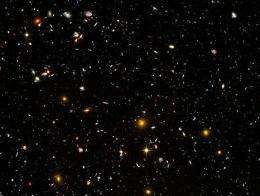January 31, 2015 weblog
Galaxy dust findings confound view of early Universe

What was the Universe like at the beginning of time? How did the Universe come to be the way it is today?—big questions and huge attention paid when scientists attempt answers. So was the early-universe discovery that made the news last year a mistake?
Some researchers in March last year had used a telescope at the South Pole, namely the BICEP2 telescope, which studied a small patch of sky in detail above the South Pole. They discovered primordial gravitational waves. This in scientific circles was a very big deal, on the level of a "big bang" look at the birth of the universe. New Scientist compellingly described it back in March, "showing us what was happening in the first slivers of a second after the big bang."
However, reported Jacob Aron in New Scientist on Friday, "details of a new analysis of their results have leaked, and they seem to reveal that galactic dust is the likely cause of their observations." Scientists working with the BICEP2 collaboration at the South Pole had announced what was said to be the first clear sign of gravitational waves, said New Scientist, found in maps of the earliest light emitted after the big bang. The waves' swirls were more pronounced than the team expected, with models suggesting the gravitational waves would be "incredibly weak," even undetectable. The BBC explained that "twists, known as B-modes, are an imprint of the waves of gravitational energy that would have accompanied the violent growth spurt that occurred almost 14 billion years ago."
BICEP sought characteristic swirls in the polarization of the Universe's oldest light. Swirl-seeking BICEP2 used a detector in a telescope to study light coming to Earth from the edge of the observable Universe, the Cosmic Microwave Background (CMB) radiation. The new twist to this story: a new study appeared to conclude, "The signal had been confounded by light emission from dust in our own galaxy," in the words of Jonathan Amos, BBC News science correspondent, on Friday. However, the summary of the paper was only posted briefly on an official French website and then pulled. The team itself had already made known its reduced confidence in the detection. But the new paper is significant because, said the BBC, it was co-authored by scientists from the Planck Consortium, researchers operating a European Space Agency satellite.
"The information was not supposed to have been released until early next week, when the actual paper itself would have been put up on the Arxiv pre-print server," said Amos.
Jacob Aron similarly wrote on Friday: "Rumors earlier this week suggested their joint paper was due to be published in the coming days, but a leaked press release on a French official Planck site has already revealed the results. The page has since been taken down but was available in Google's cache."
Dust can polarize light, masking patterns created by inflation. The dust complication was described by Amos: "Nearby spinning grains can produce an identical polarization pattern, and this effect must also be removed to get an unambiguous view of the primordial, background signal." The BICEP2 team was well aware of this potential complication and the team used every piece of dust information it could source. However, it did not have access to dust data being compiled by the Planck space telescope, which had mapped the microwave sky at more frequencies than BICEP2.
Unlike BICEP2, said an earlier report in New Scientist, which only looks at a small patch of the galaxy, Planck scanned the polarization of the entire sky between 2009 and 2012. Planck was able to more easily characterize the dust and discern its confounding effects, said the BBC. The Planck consortium agreed to start working with BICEP2. In turn, said Amos, "the results of the joint assessment leaked by the French Planck HFI website would suggest that whatever signal BICEP2 detected, it cannot be separated out at any significant level from these other spoiling effects."
More information: UPDATE: Planck: Gravitational waves remain elusive: phys.org/news/2015-01-planck-g … ational-elusive.html
© 2015 Phys.org





















